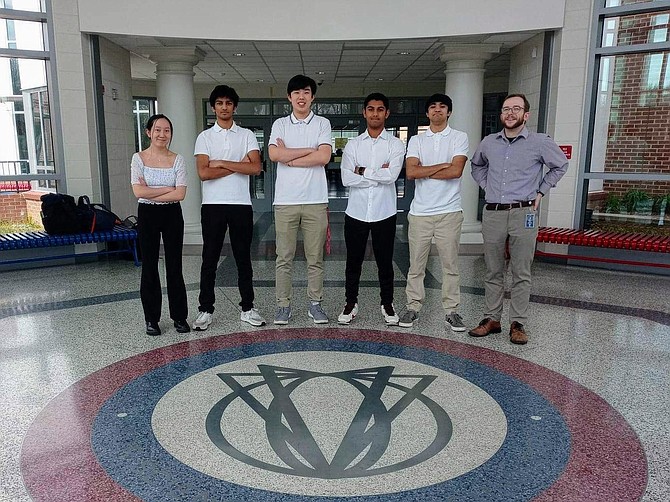Thomas Jefferson team, from left: Laura Zhang of Vienna; Om Gole of Fairfax; Jerry Sheng of Fairfax; Rishabh Prabhu of Vienna; and Rishabh Chhabra of Herndon. Math teacher Quinn McFee on right
Thomas Jefferson team, from the left, Laura Zhang, Om Gole, Jerry Sheng, Rishabh Prabhu, Rishabh Chhabra. Math teacher Quinn. McFee at the right..jpg
For 14 straight hours in early March, a small group of Thomas Jefferson High School for Science and Technology (TJHSST) students came together to participate in an international online math modeling competition. A combination of math smarts and creative thinking has added up to a spot in the finals for the team, whose submission was selected as one of the best solutions to questions around the predicted growth of e-bike use and its impact on society.
The students – Rishabh Chhabra of Herndon, Om Gole of Fairfax, Rishabh Prabhu of Vienna, Jerry Sheng of Fairfax, and Laura Zhang of Vienna, who attend TJHSST – are being recognized as one of the six overall finalist teams and one of the three finalist teams for the Technical Computing Scholarship Award in MathWorks Math Modeling Challenge (M3 Challenge). The competition drew nearly 3,000 11th and 12th graders in the U.S. and sixth form students in the U.K. this year.
The TJ team, whose work underwent intense scrutiny by judges in the first two rounds of assessment, has one last hurdle on April 24, when they present their findings to a panel of professional mathematicians for final validation.
Using mathematical modeling, students had to come up with solutions to real-world questions: How many e-bikes will be sold in the next two years? Of the many factors that contribute to e-bike use and sales growth, which are most significant? For a given country or region, can we quantify the impact that e-bike use has on carbon emissions, traffic congestion, or other key factors?
A total of 650 teams submitted papers detailing their recommendations. Roughly 45% of those submissions included technical computing to support and enhance their solutions, and those coding skills make them eligible for additional scholarship prizes.
Now in its 18th year, M3 Challenge is a program of Society for Industrial and Applied Mathematics (SIAM) and is sponsored by MathWorks.
“These students worked so hard through their own independent research and applying background knowledge from courses at our school,” says TJHSST teacher-coach Quinn McFee. “They have really expanded their statistical tool belts throughout this whole year of preparation.”
Team member Jerry Sheng found M3 Challenge to be a foundational math experience that advanced his understanding of society. “My friend and I attempted M3 Challenge together for the first time last year. Going in with little experience in the field of mathematical modeling, we were immediately exposed to techniques and concepts crucial to analyzing any problem. This year, our team dedicated much time to preparing for the Challenge. … Math modeling gives us invaluable skills not only in math, but in how you tackle any question life may throw at you. Plus, this year’s problem has persuaded me to buy an e-bike in the future.”
To access this year’s challenge problem, visit https://m3challenge.siam.org/practice-problems/2023-problem-ride-wind-without-getting-winded-growth-e-bike-use.
